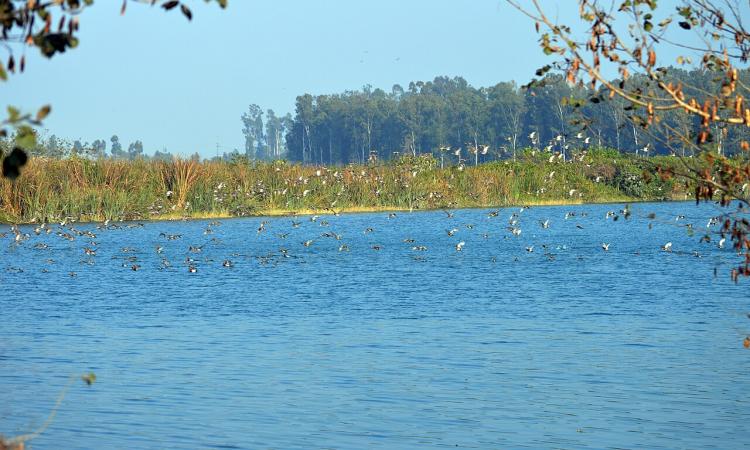
Heavy metals can harm aquatic life in freshwater bodies
While heavy metals are found naturally in the environment, their increased concentrations in aquatic ecosystems can be extremely harmful to the organisms living in the water. Anthropogenic activities such as industrial processes, mining, and agriculture can lead to an increase in heavy metal concentrations in water bodies in addition to natural causes like geological breakdown of rocks and minerals. The seepage of metals from waste disposal sites and the use of metal-based compounds in agriculture also contribute significantly to this pollution.
Once introduced into aquatic environments, heavy metals like chromium, mercury, lead, cadmium, and arsenic prove to be highly toxic harming aquatic life, disrupting microbial ecosystems and causing physiological stress in plants and animals and includes chlorosis, impeded growth, reduced biomass production, and the generation of free radicals that damage plant and animals living in the water. These impacts highlight the need for a deeper understanding of heavy metal pollution in aquatic systems.
This paper titled 'The impact of heavy metal concentrations on aquatic insect populations in the Asan Wetland of Dehradun, Uttarakhand' published in Nature Scientific Reports discusses the findings of a study that looked at the impact of heavy metal pollution on the distribution and biodiversity of aquatic insects in the Asan Wetland of Dehradun, Uttarakhand. The research used data collected from three sites within the Asan Wetland in Dehradun, Uttarakhand.
Aquatic insects form an integral part of freshwater ecosystems and play critical roles in nutrient cycling, energy transfer, and maintaining food webs. They are highly sensitive to changes in water quality and are often used as bioindicators to detect environmental changes in water bodies.
The Asan wetland
The Asan wetland has been officially designated as the Asan Conservation Reserve following the construction of the barrage in 1967 at the confluence of the Asan River and the outlet channel of the Dhalipur power station. The wetland is made up of a dense Sal Forest, cultivated and pastured lands, the Rampur Forest Block, mixed forests, and land owned by the irrigation department made up of shallow and deep-water regions.
The Asan River, a tributary of the Yamuna River, flows through the wetland, and the western side of the wetland has the 287.5-m-long barrage, with a water level maintained at 403.3 m above sea level. The wetland is recognised as one of the biodiversity hotspots and environmentally significant habitats in the Doon valley and has been declared as a conservation reserve by the Government of Uttarakhand.
The study findings
- Heavy metal pollution was high in the wetland and it was found that the cadmium, copper, arsenic and lead concentrations were maximum in the month of August and minimum in January respectively. Thus, heavy metal concentrations demonstrated their highest average values during the monsoon season, followed by summer, and the lowest values during winter. Seasonal dynamics and environmental factors played an important part in determining the concentration and distribution patterns of heavy metals in the wetland.
- The maximum density of aquatic insects was found during the month of January while the density was found to be the lowest during the month of August. The insect density was high due to the presence of favourable environmental conditions in the winter, but the unsettled ecological conditions and increase in heavy metal concentration restricted the growth of aquatic insects during the monsoons. Anthropogenic disturbances resulting from activities such as boating, tourist movement, oil leakage from motorboats, and other human-induced factors were also found to reduce the density of aquatic insects in the wetland.
- The densities of aquatic insects were found to be at their lowest in July and August and started to increase from September and remained consistently high until the month of April. This was due to the sediment load transported by the Yamuna and Asan rivers during the monsoon period, which led to deposition of fine particles and disruptions in the littoral zone, leading to elevated concentrations of heavy metals in the water. This increased sedimentation and heavy metal levels in the rivers led to reduced water transparency impacting primary production in the wetland. Food availability for the insects (macroinvertebrates) was thus scarce during this period, compounded by the submergence of the littoral zone. This led to reduced densities and biodiversity among aquatic insects.
- The aquatic insects were sensitive to heavy metals and when concentration of heavy metals increased in monsoon season the macroinvertebrates showed decrease in density and diversity. The maximum richness and density of benthic fauna were observed during the winter season, which is favourable due to lower temperatures and higher levels of dissolved oxygen and abundant availability of phytoplankton as a food source.
- Aquatic insects decreased during the rains due to increased surface runoff containing untreated sewage, dilution effects, and the presence of contaminants that increased the load of suspended solids, reduced water transparency, and resulted in increased water flow, ultimately affecting the distribution of organisms living in the water. The elevated concentrations of heavy metals, especially during summer and monsoon seasons, are attributed to higher evaporation rates and environmental factors.
The paper argues that:
- There is a critical need for effective monitoring and management of heavy metal contamination to safeguard freshwater ecosystems and the vital ecological services provided by aquatic insects.
- Further research and conservation efforts are urgently needed to fully understand the long-term effects of heavy metal pollution and to develop comprehensive strategies for mitigating its impact on aquatic ecosystems.
/articles/aquatic-insects-choke-heavy-metals-poison-asan-wetland